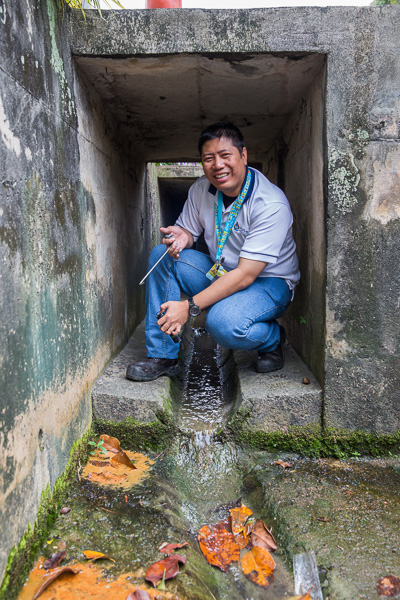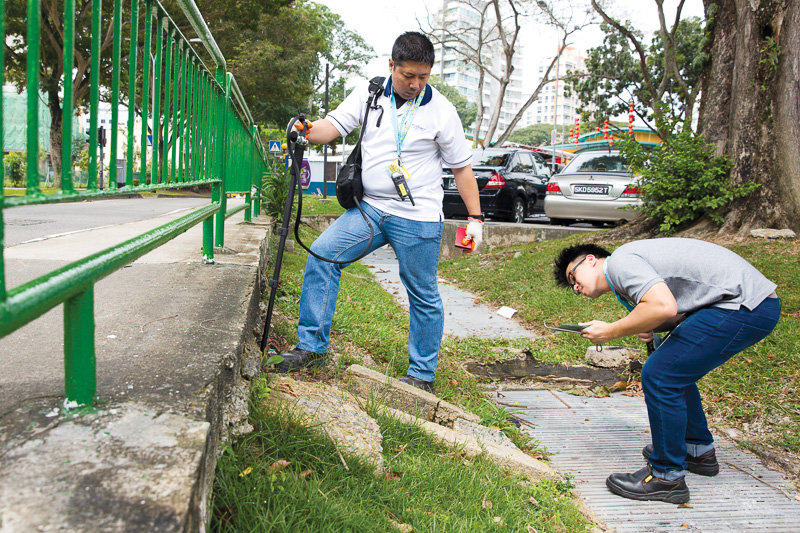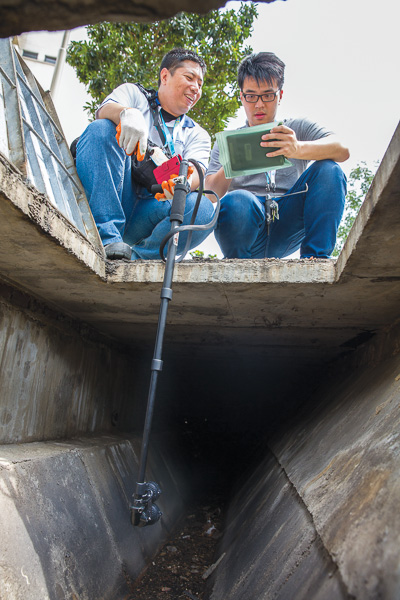Behind the Scenes of a Flash Flood

When it pours, most people run for cover, but not Mr Decry Hardiyanto Zaidi, a technical officer from PUB, Singapore’s national water agency.
In fact, once a heavy rain warning is issued, he and eight colleagues from PUB’s Quick Response Team are ready to fan out to different parts of Singapore to manage floods.
The quick responders work on a roster – weekends and public holidays included – so they are ready for rain 24/7.
When there is an impending storm, Mr Decry gets an SMS alert from the Meteorological Services 30 to 45 minutes before heavy rain is expected. Another SMS from PUB’s Operations Room prompts him to get ready to head outdoors.
Huddled in the PUB Operations Room are engineers who monitor water levels in drains and canals – captured by 158 sensors island-wide – and traffic conditions through CCTVs. Observing cloud and rain movement patterns through radar and satellite images, PUB officers then send a more specific SMS to Mr Decry, informing him exactly where to go.
Once he gets this alert, Mr Decry and a colleague head out in a PUB van that has been modified to withstand floodwaters.
The van is equipped with traffic cones for marking flood sites or diverting traffic, inflatable sand bags filled with a polymer that absorbs water, and hooks for lifting up drain covers so that Mr Decry can check if drains are choked.
“Safety boots are a must, because … sometimes the drain cover can slam down on your feet,” says Mr Decry, “and wearing boots also makes it easier for me to move in floodwaters.” On location, he opts for raincoats over umbrellas to keep his hands free, so that he can investigate possible flood causes and check on updates from the Operations Room.


Two-way communication
The 39-year-old uses mobile devices to report flood depths and beam photos taken on-site back to the Operations Room. The quick responders – who act as PUB’s eyes and hands on the ground during floods – are able to feed detailed information back to the engineers, who then inform the public by publishing “live” updates on water levels and flash floods on radio, Facebook, Twitter, SMS and the agency’s MyWaters app.
Sometimes “there is water everywhere and [the technical officers] may not be able to see the drains,” says Mr Choy Wai Kwong, PUB’s Deputy Director of Drainage Operations. During instances like this, the engineers – who have access to Singapore’s drainage maps and an overall picture of the flood situation back at the Operations Room – send information back to the quick responders. They direct them where to go and which drains to check.
Flash floods occur when there is intense rain or heavy rain coinciding with high tides. Sometimes flash floods occur when objects, such as leaves, block drains. Mr Decry will remove such blockages on the spot if he can.
Another challenge is getting stuck in traffic on the way to a flash flood site. Singapore’s fickle weather means heavy rain can stop after just 15 minutes. “I need to reach flash flood locations in the quickest time possible, so I sometimes get frustrated when our vehicle is stuck in a jam,” says Mr Decry.
But even if he arrives at the site after flash floods have abated, there are ways to check on water levels so he can report back. For instance, Mr Decry looks for flood marks like leaf debris left behind on walls.
Following Mr Decry and his team’s reports and feedback, PUB officers will visit the sites to further investigate the causes of flash floods. They will check, for example, whether they need to upgrade the drain, or do minor modifications to the drainage system, says Mr Choy. He adds that the Quick Response Team’s work helps PUB come up with long-term solutions to prevent a flash flood from happening at the same site again.
Dry runs
Fair weather doesn’t mean a dry spell of work for the Quick Response Team. Even when skies are clear, Mr Decry is out of the office, carrying out his routine duties.


Every day, he checks the drains under PUB’s charge for chokes or defects that may contribute to flash floods, as well as damaged railings that could be dangerous for the public. He collects water samples for laboratory testing, when there are cases of suspected water pollution. He also visits dengue hotspots to check that drains are working well.
The Quick Response Team also responds to calls for assistance from the public or directs them to the appropriate government agency. The team often has to retrieve items that have fallen into drains or canals, such as balls and mobile phones, and even have had to rescue dogs.
Mr Decry remembers getting an urgent request for help on Christmas Day 2012, just as he was knocking off. A member of the public had dropped a skateboard into a canal. Although it was after office hours, he and his colleague activated their contractors to meet on-site. Eventually, the skateboard was retrieved.
“The customer was very thankful for our help,” says Mr Decry. The woman’s young son had been playing with the skateboard, a Christmas gift, when it fell into the canal.
Gestures of appreciation from the public keep Mr Decry going. “I enjoy being able to resolve customers’ issues and seeing their happy or relieved faces. And it’s a new case every time.”
Rain-spotting

After 14 years at PUB, Mr Decry can more or less tell whether rain will be heavy or last long. “I’ve learnt how to spot where the rain is moving, and whether it’s going to grow or dissipate.” He combines information on wind direction, provided by the National Environment Agency, with some basic calculations. “If the wind blows to Singapore from the south, and the speed is 20 to 25 kilometres per hour, we can expect [the rain] to clear within half an hour, provided it doesn’t grow,” he shares.
- POSTED ON
Mar 7, 2014
- TEXT BY
Siti Maziah Masramli
-
Unsung Heroes
Your Facebook Friends









